- Iceland
- South Iceland
- Discover the glaciers of southern Iceland

Ah, the south of Iceland with its glaciers, waterfalls and long black sand beaches. So many memories that still emerge freshly more than a year later. In this article we will focus on the impressive glaciers of the south of the island, as it is in the south of Iceland that most of them are found. It's impossible to miss them because they are so present.
Summary
1The impressive Vatnajökull
The biggest of them is the huge Vatnajökull. It is so big that it is impossible to imagine its span from the ground. It is one of the largest glaciers in the world! It is the second largest glacier and the second largest glacier in Europe. And for good reason, it covers more than 8,000 km², or 8% of Iceland, with a thickness of up to 1,000 meters, for an average of 400 meters! Imagine that ice monster! Do the math and you will also see that its weight is just surrealist. Moreover, the pressure he exerts on the soil of the small island is enormous, so much so that he pushes it into the earth's mantle.
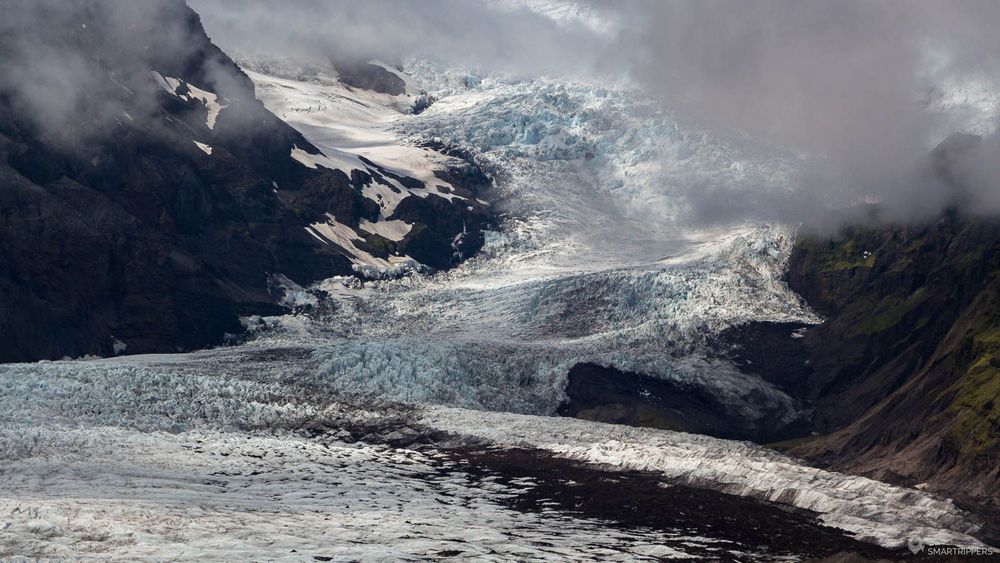
The whole of the Vatnajökull is included in the Vatnajökull National Park. And you will also notice that the ending "jökull" means "glacier" in Icelandic, a name that will be found a lot on Icelandic maps, but also in this article.
Volcanoes and Jökulhlaup
The Vatnajökull is far from harmless. Under the ice monster there are dozens of volcanoes, which awaken in turn, and rather regularly. During an eruption, the ice melts abruptly in contact with the heat, causing huge catastrophic floods called Jökulhlaup, taking everything with them.
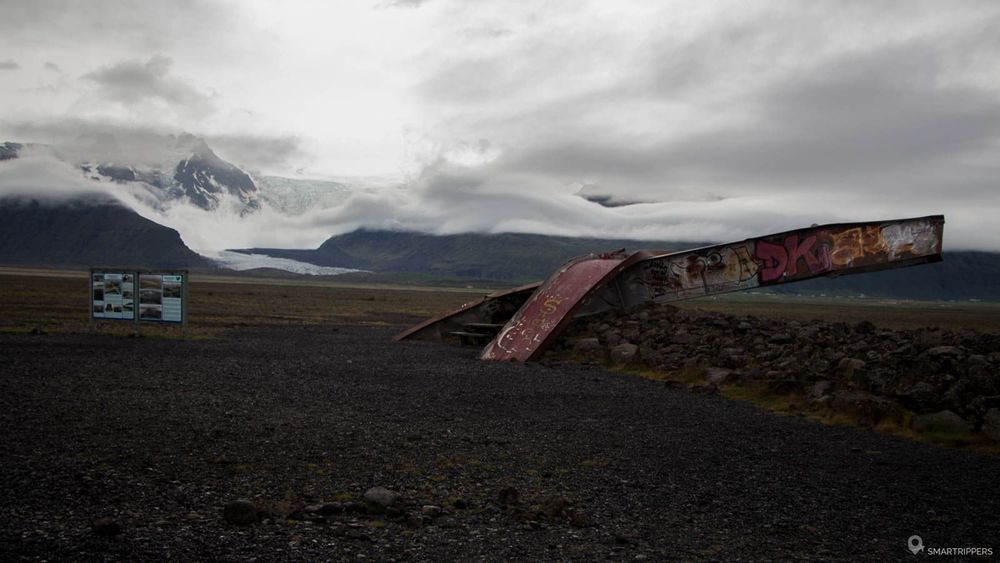
The last Jökulhlaup took place in 2010, during the eruption of the Eyjafjallajökull, but it was the eruption of the Grímsvötn in 1996 that caused the greatest damage in last decades. The Jökulhlaup usually last several days, taking roads and bridges along their way. The traces are still clearly visible today in the southern part of Vatnajökull before reaching Skaftafell. Since 2010 new bridges have been built in areas considered safer, but the remains of the old structures are still present, as a reminder that mankind is very insignificant when nature rumbles.
Glacier and global warming
The Vatnajökull is so large that its extremities end in a sort of small, narrow and long glaciers. But here, the word "small" is relative as everything is on an oversized scale! There are about 30 glaciers extensions scattered all around the large glacier, and they are most numerous south of the ice cap.
Unfortunately, global warming is affecting Vatnajökull, which is shrinking from year to year. Studies show that the glacier may have disappeared in 100 years.
From Route 1, you can easily discover the great glaciers that shape the landscape. Let's discover them from west to east.
2The Vatnajökull's glacier and secondary glaciers
The Skeiðarárjökull
The Skeiðarárjökull is the first glacier from the Vatnajökull, visible from Route 1 from the west. Impossible to miss it, it is impressive despite the fact that it is located 5 km from the road. Its front extends for almost 15 km and goes up to the centre of Vatnajökull for almost 30 km.
For long minutes our car ran along this impressive glacier without leaving it. It is at this moment that one becomes aware of the immensity of the Skeiðarárjökull, which is only a very small part of the Vatnajökull.
It is this same glacier that was at the origin of the powerful 1996 Jökulhlaup, whose remains can be seen on the right-hand side of Route 1, about 3 km before reaching Skaftafell. Here, some panels tell the facts of 1996 in pictures.
The Skaftafellsjökull
The Skaftafellsjökull's glacier is much smaller than the previous one, but still very impressive. It is located directly after the Skaftafell campsite. From here, a 2 km long one-way trail leads to the glacier, and reaches the edge of the lake at its foot. It is not uncommon to see small icebergs.

Hikes with crampons can be made on the glacier, supervised by professionals. It is recalled that venturing out on an ice-cream pad alone, without equipment and without knowledge of the place is extremely dangerous. Water digs the ice beneath the surface and unsuspected cavities are constantly created, making the glacier unpredictable and dangerous. People have already lost their lives on Iceland's glaciers and the commemorative plaques will remind you of this.
The Svínafellsjökull
A few kilometres from Skaftafell is the beautiful Svínafellsjökull glacier. Easily accessible by a small unpaved road, don't miss to stop and discover the glacier and its small iceberg lake. Here, the water is rather muddy, but the charm is no less.

The pieces of ice still bear the blackish traces of the ashes from the last eruption of the Eyjafjallajökull, which magnifies the contrasts on the ice. From the lake, the glacier stretches upwards. Take a few hundred meters of the path that starts from the car park to have a more unobstructed view of the glacier. You will then see the glacier's heights appear, tinged with an incredible sky blue! For more information and photos, please visit our article dedicated to the Svínafellsjökull.
The Kviárjökull
It was by chance that we discovered Kviárjökull glacier, a part of the Öræfajökull, a secondary glacier from the Vatnajökull, which is a little further back from the road. Halfway between the Skaftafellsjökull and Jökulsárlón, the access to the Öræfajökull is simply signposted from a small sign indicating Kviamyrarkambur. A dirt road of about 300 meters leads to a car park. Then, a path climbs up small hills that will allow us to take a little height to admire the glacier from above.
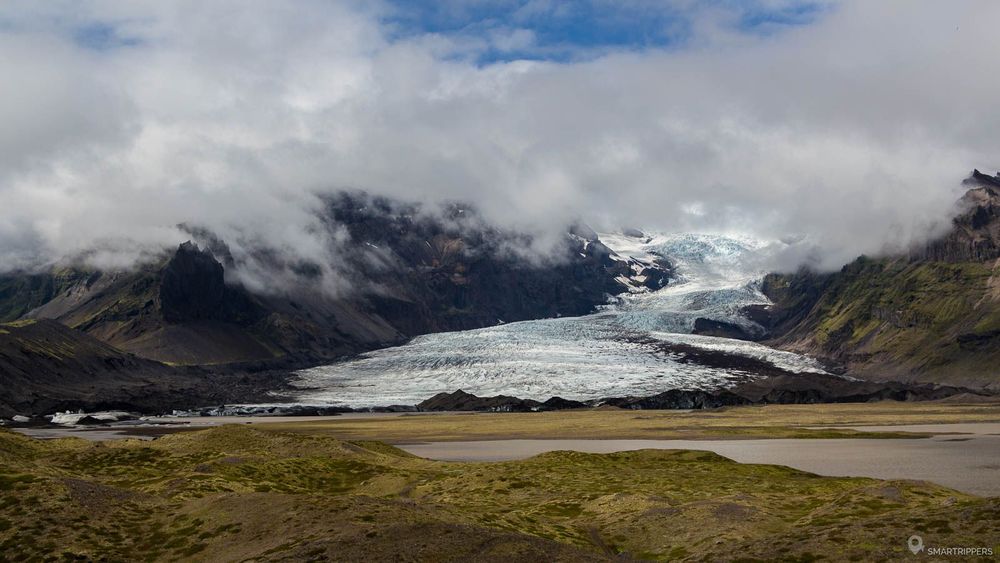
This time the observation is done from a little further away, but the panorama is really nice, especially when the sky is clear.
Fjallsjökull and its lake, Fjallsárlón
Near Route 1 is the Fjallsjökull and its iceberg lake, the Fjallsárlón. This little gem was still a little-known place a few years ago, but it was without counting on the arrival of mass tourism in Iceland. Today, the lake has become an almost as popular attraction as Jökulsárlón. It is also possible to make boat tours.

The Fjallsjökull glacier ends its journey in a small lake. The opposite bank is not far away, which allows you to admire the icebergs and glacier at the same time. What's interesting is to stay and watch the icebergs drift and hear large blocks of ice crumbling away from the glacier in a huge crash. There is an isolated point of view, still little known because it is accessible after an unpaved track of about 1.5 km and not yet marked in 2016. To get there, we give you all the information in our article dedicated to Fjallsárlón.
The Breiðamerkurjökull and its lake, Jökulsárlón
This is one of the most popular places in Iceland. The famous iceberg lake of Jökulsárlón was formed following the melting of the Breiðamerkurjökull's glacier. The show is fascinating! Today, the lake is growing larger and larger, so that the glacier front is now 3 km from the sea and can only be seen if the weather is clear. The lake ends its journey in the ocean, passing through a small channel where the pieces of ice pile up before running aground along the immense black sand beach that borders the area. Boat tours are organized all year round to get a closer look at the icebergs (but we don't endorse them).
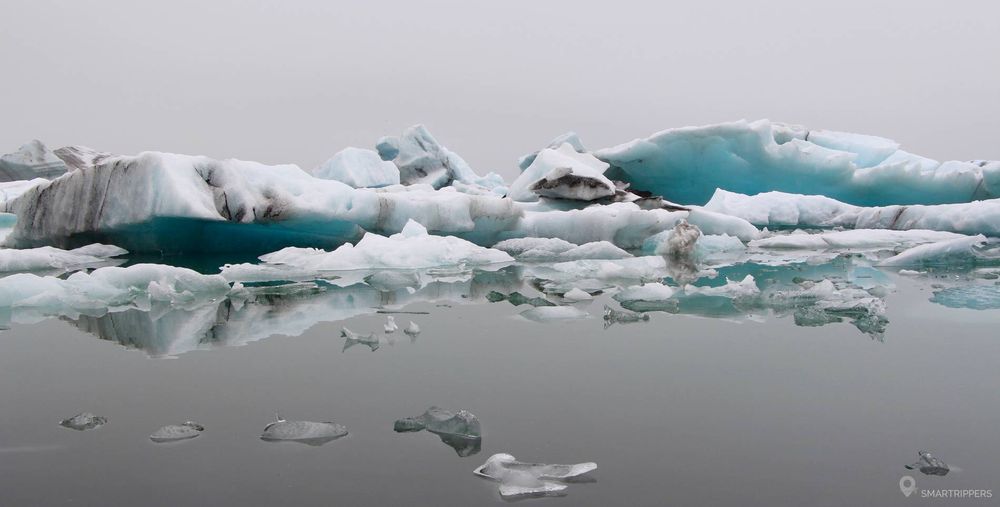
Take your time to discover the Jökulsárlón lagoon and don't stop at the two large car parks on either side of the channel. Solitary and much more impressive points of view are accessible from small car parks located upstream, before reaching the channel. You will find all the details in our article dedicated to Jökulsárlón.
3The Mýrdalsjökull
The Mýrdalsjökull is another large glacier located west of the Vatnajökull. With its 596 km², it is the 4th largest glacier on the island. Road 1 runs along it for more than 40 km, but the glacier is located about 10 km from the road, and it is mainly on the other side of the road, from the F210 that the view is most spectacular. A route that is also recommended for all adventurers equipped with a good 4x4. You will find more information in this article dedicated to F210 track.
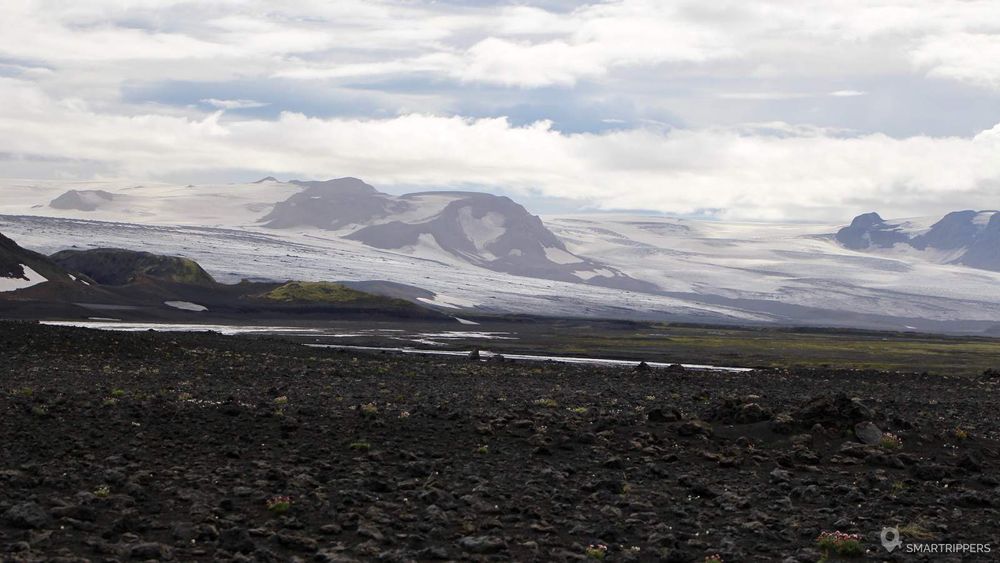
The Mýrdalsjökull is now under close surveillance as it hosts several volcanoes, including the famous Katla, whose crater is buried under several hundred metres of ice. Its eruptions are fairly regular, and there is every indication that the next eruption may be taking place in the near future. This could then have devastating consequences, following the formation of huge Jökulhlaup.
The Sólheimajökull
Sólheimajökull is the only glacier of the Mýrdalsjökull which is located in the south of the island, making it easily accessible from Route 1. It is also probably the first glacier you will discover during your stay in Iceland if you turn counter-clockwise.
The Sólheimajökull stretches for nearly 10 km towards the ocean. The glacier is majestic, still slightly tempted by the black ashes projected by Eyjafjallajökull in 2010. To get close to it, you must use Highway 221 for 4 km, which is well signposted from Highway 1. Once you arrive at the car park, you will have to walk for about 15 minutes on a path without difficulty.
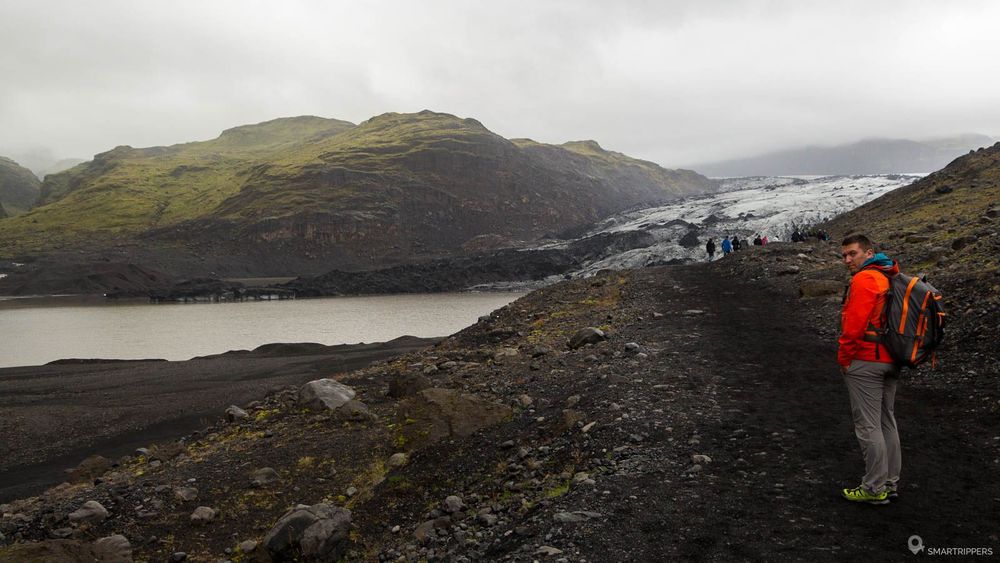
At the end of the trail, a rope will stop you from going further unless you are guided on a glacier excursion by a guide. Indeed, as mentioned above, walking on the glacier is very dangerous, as ice can break on your weight. But from here, we can already have a very interesting view of the glacier and above all admire its impressive dimensions.
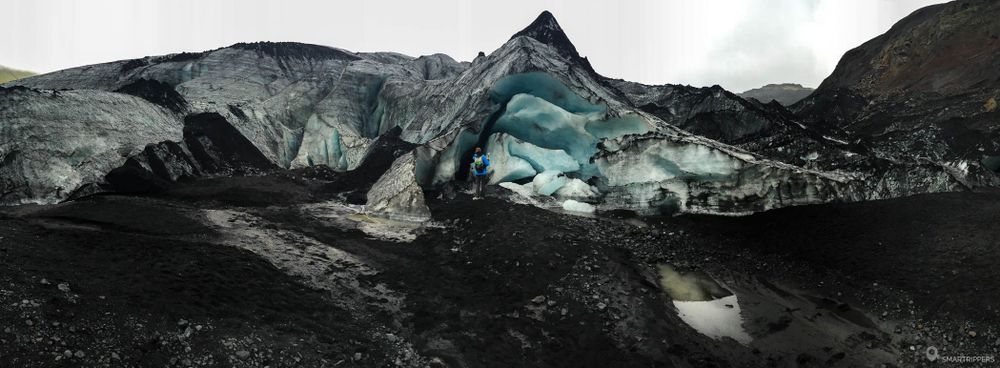
Nevertheless, we braved the ban to get close to the ice and discover the big cavities of a fascinating blue. We continued the few tens of meters while being very careful to always stay on the earth. But it was when we came back that we found out that we had actually been mounted on a large block of ice, itself covered with earth. Looking closer, we see a large stream of water coming out of this block of ice a few meters further, indicating that our path was actually just over a layer of ice above a river. What was nothing but curiosity could have ended in drama if the ice had given way under our weight, taking us with the current...
4The Eyjafjallajökull
The Eyjafjallajökull was made famous in 2010 by the eruption of its volcano, which disrupted air traffic for weeks. But above all, it is a 78 km² glacier, just 2 km from its neighbour, the Mýrdalsjökull. Its smallest surface area ranks it in 6th place among Iceland's glaciers.
Viewpoint on the Eyjafjallajökull
From Route 1, a viewpoint has been set up to see the glacier and above all the top of its mediatized volcano. Some panels tell the story of the two eruptions in 2010.
Today, the ice has returned to its place and the volcano is now covered with a thick white mantle.
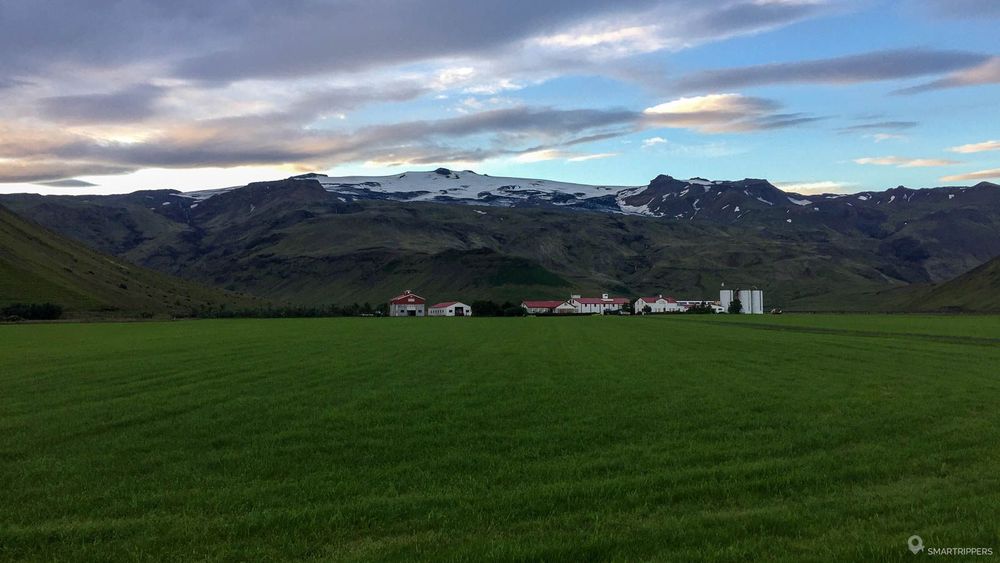
We are coming to the end of this article. Of course there are dozens of other glaciers belonging to the Vatnajökull, but we did not have the opportunity to explore them. Don't hesitate to share your discoveries with us!
We are Sandrine and Flo, French thirty-somethings. In 2019 we quit everything to live our dream, become nomads and travel around the world. We left with our baby, Lena, who was only 5 months old at the time. After a first trip around the Pacific Ocean by plane and a long 3 months stay in Hawaii, we left to discover Iceland for 3 months on board our 4WD pickup truck and truck camper. Then we continued our adventure in North America.
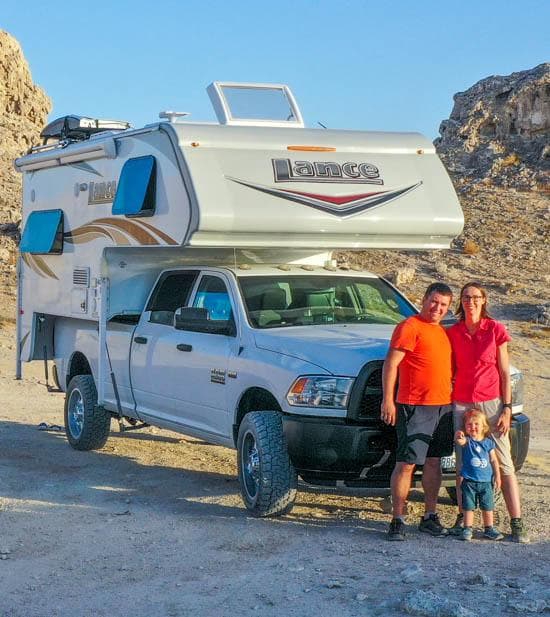
Today, if we can continue this adventure, it is above all thanks to our blog, Smartrippers! We created it one day in 2016, with the desire to share our good travel tips, without thinking that it would lead us there! We have developed it a lot over the years and have become experts on our 3 favorite destinations: Hawaii, Iceland and the American West. We now guide you to these destinations to help you plan the trip of your dreams!
Follow our adventures!